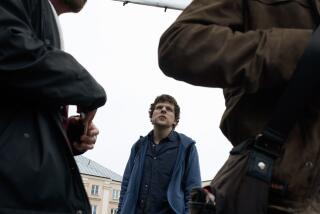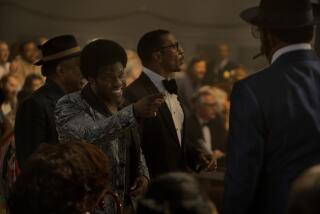Movie Reviews : ONE HITS ITS TARGET; ANOTHER NEARLY DOES : ‘Full Metal Jacket’
In “Full Metal Jacket” (selected theaters), Stanley Kubrick brings his rigorous, artist’s eye to Vietnam to create a powerful and centered statement of outrage. Although its two sections are not perfectly balanced, it is a muscular return to form for the man who made “Dr. Strangelove” and “A Clockwork Orange.”
It may seem too spare, too clinical, its moments of war even too familiar for some. But, aiming for minds as well as hearts, Kubrick hits his target squarely.
Unfortunately, it is not possible to write about “Full Metal Jacket” without some reference to “Platoon,” but it should be. Oliver Stone and Kubrick share only a subject; their techniques and their intentions are as different as the backgrounds of their films, the lush, encroaching jungle of “Platoon” and the rubble-strewn cement cityscape of “Full Metal Jacket.”
Stone spared us very little; his most astonishing feat was to make every person in the audience feel viscerally the terror and confusion of the ordinary infantryman. Kubrick takes one step farther back. He doesn’t put us in the boots of his Marines, and he’s scrupulous to avoid any suggestion of heroic behavior that might win our sympathies cheaply. His vision is, if possible, more terrifying than Stone’s because it is without redemption.
As “Full Metal Jacket” begins, the camera stares into the open, apprehensive faces of young recruits as the electric clippers of the Marine barbers reduce them to prisoner-like skinheads in 30 seconds. It will be the lightest indignity they suffer.
For the next three-quarters of an hour, in sequence after pitiless sequence, abuse pours over them like Parris Island sunlight. Kubrick shows us how the Marines, in the person of the inexhaustibly scatological Gunnery Sgt. Hartman (Lee Ermey), their relentless drill instructor, makes ordinary young men into fighter-killers in only eight weeks.
The ritual of these 17- and 18-year-olds is constant. As they throw themselves over obstacle courses or practice rifle drills, Hartman’s furious face is never more than inches away from their eyes, barking at them, screaming at their putrid worthlessness, brutalizing them physically, humiliating them in every way.
One recruit bears the brunt of the degradation, a fat, sweet screw-up (Vincent D’Onofrio) whom Hartman nicknames Gomer Pyle and badgers and taunts until he cracks or becomes, in Hartman’s view, squared away--a good grunt.
(In a superb cast of mostly unknowns--with the exceptions of Matthew Modine and Dorian Harewood--D’Onofrio, who put on 60 pounds to play this pivotal role, and Ermey are exceptional. Ermey was a Marine drill instructor and a Vietnam vet, as well as a technical adviser and occasional actor, but this takes away from his driving performance not a whit; he’s not just playing himself any more than Dexter Gordon did in “ ‘Round Midnight.”)
The training sequences affect audiences in two ways: There is explosive, nervous laughter at the sheer inventiveness of the drill instructor’s invective; others shrink from its almost unendurable impact. But this perversion of the innocent is at the heart of Kubrick’s vision, and he shapes it into an experience so horrifying that the tension of the eventual battle scenes are almost a respite.
In the film’s second section, we follow two men of this platoon, the wisecracking Joker (Modine), who now works for Stars and Stripes, and Cowboy (Arliss Howard), to the boredom and corruption of Da Nang, then through the bombed, barren ruins of Hue City for the seemingly directionless skirmishes of the 1968 Tet offensive. They’re in the company of the hulking young killer, Animal Mother (Adam Baldwin), Eightball (Harewood) and the baby-faced newcomer, Rafterman (Kevyn Major Howard), Joker’s photographer.
Back-up forces that don’t arrive, squads who find themselves off-course in a bullet-riddled city that might be Beirut or Berlin--these are moments of battle we’ve seen before, in other movies or on the 6 o’clock news. But Kubrick gives it all a lacerating edge.
The scene of the Southern door gunner, firing cheerfully on Vietnamese civilians from his helicopter, and announcing his box score--157--could be out of “Dr. Strangelove” if it didn’t have so ominously truthful a feel to it.
The script should sound right; it’s by Michael Herr, whose “Dispatches” was arguably the Vietnam War memoir; by Kubrick and by ex-Marine combat correspondent Gustav Hasford, on whose devastating novel, “The Short-Timers,” the film is based. And Anton Furst’s production design, a kind of theatrical realism, as well as Abigail Mead’s score, which mixes some of the more mindless ‘60s songs with measured drumbeats and what sounds like a rusty hinge in a wind, are in large part responsible for the film’s penetrating mood.
There are grotesquely comic moments which have the Kubrick eye: During an exchange with the enemy, three TV newsmen, mikes and cameras at the ready, back diagonally across the action, crouching like some low-level conga line--funny, until we realize they’re in mortal danger.
His view of a Stars and Stripes editorial meeting is caustic. Lt. Lockart (John Terry), its handsome, preppy editor drills Joker, “In this not particularly popular war, it’s our job to report the news that the why-are-we-here civilian newsmen ignore.” That gives the paper two basic stories: “Winning of Hearts and Minds: Grunts Who Give Half Their Pay to Buy Gooks Toothbrushes and Deodorants,” and “Winning the War: Combat Action Which Results in a Kill.” Little wonder that cynicism is as much a part of the grunts as their sweat.
In the final burst of action, Douglas Milsome’s gliding camera moves like another squad member as a sniper--or perhaps a handful of them--pin down Joker’s group in another of Hue’s moonscape ruins. This agonizing scene, including the sniper’s identity, is meant to illuminate the moral dilemma of Vietnam. But the final one does it better: the young Marines, silhouetted against guttering flames, moving forward as they sing “M-I-C-K-E-Y M-O-U-S-E,” is Kubrick’s vision of a war that leads nowhere but into the pit, fought by boys whose basic innocence has been warped and cynically lost.
More to Read
Only good movies
Get the Indie Focus newsletter, Mark Olsen's weekly guide to the world of cinema.
You may occasionally receive promotional content from the Los Angeles Times.










